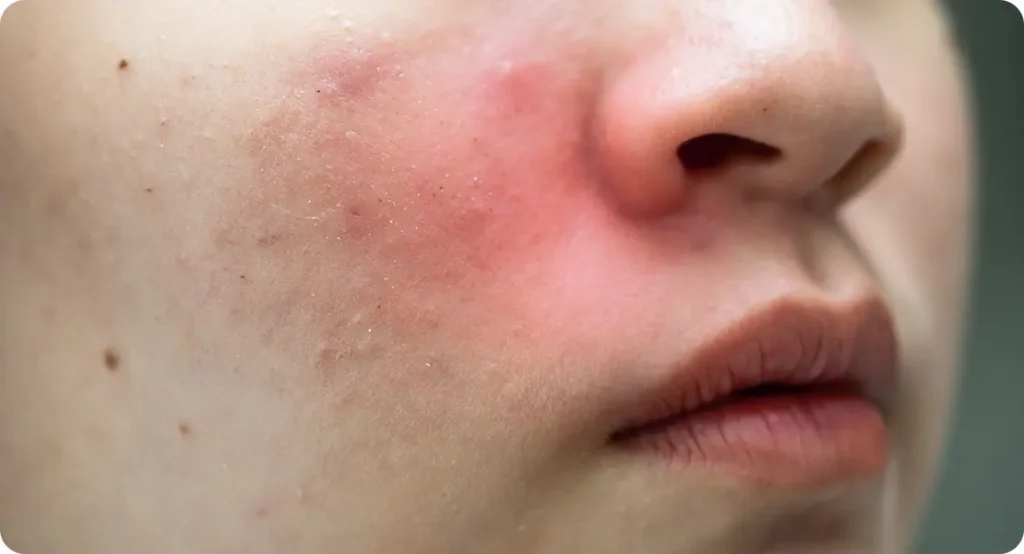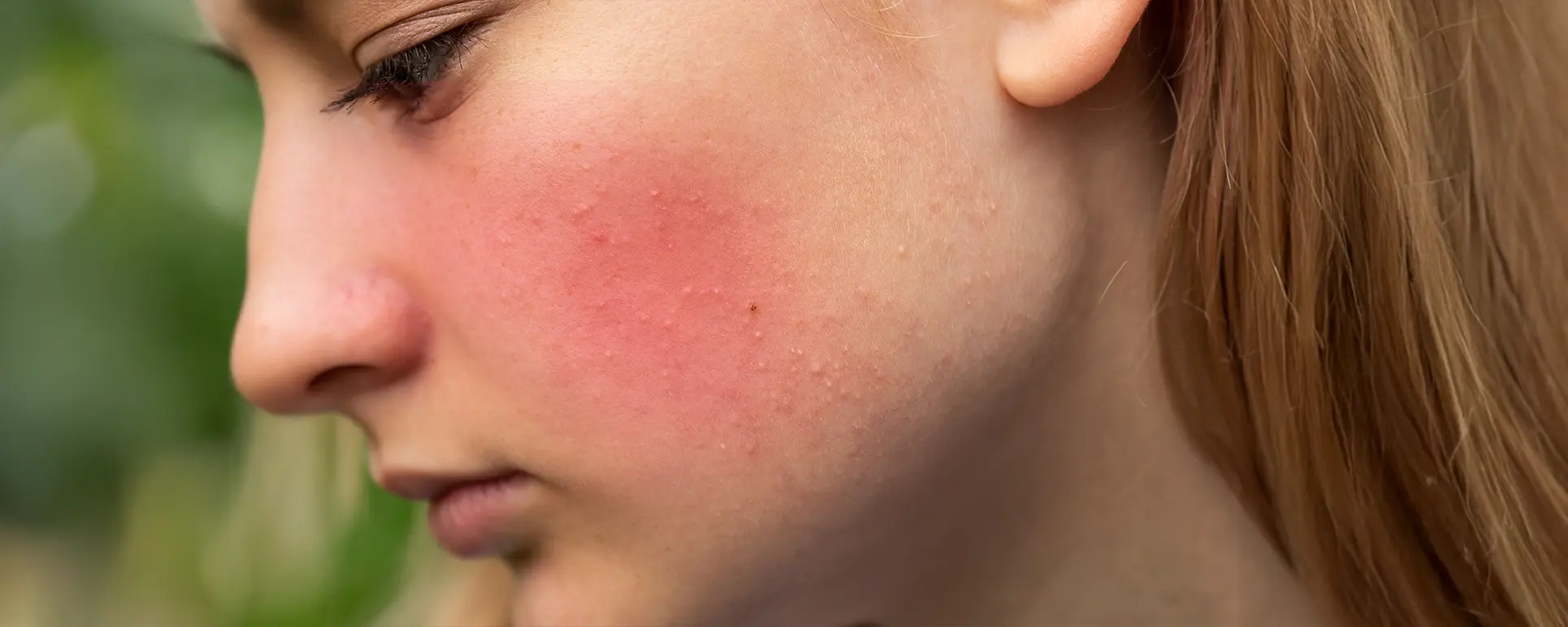Ocular rosacea is a chronic condition that affects both the eyes and the skin, often creating a range of uncomfortable symptoms that can interfere with daily life. While most people are familiar with rosacea as a skin condition that causes facial redness, flushing, and visible blood vessels, many do not realise that it can also affect the eyes, sometimes severely.
People who experience ocular rosacea often report persistent eye irritation, which can present as redness, dryness, or a gritty, sandy sensation that feels as though something is constantly rubbing against the surface of the eyes. This irritation may be accompanied by a burning or stinging feeling, light sensitivity, or occasional blurred vision. The eyelids themselves can also be affected, becoming inflamed, swollen, or developing small bumps along the lash line. In many cases, these eye-related symptoms occur alongside facial rosacea, but for some, ocular symptoms may appear independently, making recognition and diagnosis more challenging.
Understanding the signs, triggers, and treatment options for ocular rosacea is essential for effective management. While the exact cause of the condition is not fully understood, it is thought to involve inflammation of the tiny oil glands in the eyelids, which can lead to dryness and irritation of the eyes. Common triggers, such as exposure to sunlight, hot or spicy foods, alcohol, stress, and certain skincare or eye products, can worsen both facial and ocular symptoms, so identifying and avoiding these triggers is a key part of controlling flare-ups.
Treatment options for ocular rosacea often involve a combination of professional care and home-based measures. Prescription eye drops or ointments can help reduce inflammation and soothe discomfort, while gentle eyelid hygiene routines, including warm compresses and cleansing, can relieve irritation and support eye health. In some cases, oral medications may be recommended to control inflammation and prevent complications.
What Is Ocular Rosacea?

Ocular rosacea is a particular subtype of rosacea that primarily affects the eyes and eyelids. Unlike general rosacea, which is most commonly recognised by persistent facial redness, visible blood vessels, or acne-like bumps, ocular rosacea targets the delicate tissues around and within the eyes. This condition is chronic, meaning it often lasts for months or years, and it may flare up periodically in response to specific triggers, including sunlight, stress, hot or spicy foods, alcohol, or even certain skincare and eye-care products.
People with ocular rosacea can experience a broad range of uncomfortable and sometimes disruptive symptoms. The most common signs include burning, stinging, or itching sensations in the eyes, a gritty or sandy feeling as if something is constantly irritating the surface, excessive tearing, and watery or bloodshot eyes. The eyelids themselves may become inflamed, red, or swollen, and small bumps or crusting along the lash line may develop. In some cases, individuals notice increased sensitivity to light, blurred vision, or difficulty wearing contact lenses, which can make everyday activities such as reading, driving, or working on screens uncomfortable or challenging.
A complicating factor with ocular rosacea is that it does not always appear alongside visible facial symptoms. Some people may experience significant eye irritation without the classic flushing, redness, or bumps on the skin, which can delay recognition and diagnosis. This means that many individuals may struggle with eye discomfort for months or even years before understanding the underlying cause. Untreated ocular rosacea can lead to chronic dryness, persistent irritation, or, in more severe instances, damage to the cornea, potentially affecting vision over time.
Awareness of ocular rosacea and its early signs is therefore critical. Timely evaluation by a dermatologist or eye specialist can help manage symptoms effectively and prevent complications. Through appropriate treatment, including eyelid hygiene, medicated eye drops or ointments, and lifestyle adjustments to avoid known triggers, individuals can significantly reduce discomfort, protect eye health, and improve their overall quality of life, even while living with this long-term condition.
Common Symptoms
Ocular rosacea can cause a wide range of symptoms that affect both the eyes and the surrounding facial areas, often making daily activities uncomfortable or even challenging. One of the most common complaints is sore, itchy, or gritty eyes. Many people describe a sensation similar to having sand, dust, or tiny particles constantly rubbing against the surface of the eyes. This persistent irritation can make blinking uncomfortable and may worsen during prolonged screen use, exposure to wind, dust, or dry indoor environments, making it difficult to focus or keep the eyes open comfortably.
Redness is another hallmark symptom of ocular rosacea. It can affect not only the eyes themselves but also the eyelids and the surrounding facial skin. This redness may appear as a flushed or inflamed area around the eyes, sometimes accompanied by warmth, tenderness, or slight swelling. In some cases, the skin around the eyes may feel dry or irritated, and flare-ups can make the redness more pronounced, affecting both appearance and comfort.
Sensitivity to light, also known as photophobia, is a common issue for people with ocular rosacea. Bright sunlight, glare from digital screens, or artificial indoor lighting can trigger discomfort or pain, causing squinting, headaches, or the need to wear sunglasses indoors. This sensitivity can interfere with normal daily tasks such as reading, driving, or working on a computer.
Chronic tearing or dryness is another frequent concern. Some individuals may experience excessive watery eyes, while others feel their eyes are persistently dry, stinging, or burning. This imbalance often occurs because inflammation in the tiny oil glands of the eyelids prevents the tear film from functioning properly, leading to ongoing irritation, discomfort, and in some cases, blurred vision.
Ocular rosacea can also lead to frequent styes or swelling of the eyelids. Styes are small, painful lumps along the lash line that occur when the eyelid glands become blocked or inflamed. Eyelid swelling can be intermittent or persistent, adding to discomfort, affecting vision temporarily, and sometimes causing the eyelids to feel heavy or tender.
Even if facial redness is mild or not present, persistent eye irritation, dryness, or repeated eyelid issues should be taken seriously. Recognising these common symptoms early and seeking advice from a dermatologist or eye specialist can help manage the condition effectively, relieve discomfort, and prevent long-term complications, such as corneal damage or chronic eye dryness.
Triggers and Risk Factors

Ocular rosacea is a complex condition influenced by multiple factors, ranging from environmental exposure to lifestyle habits and even personal health. Identifying and understanding these triggers is crucial for managing symptoms and preventing flare-ups, which can often be uncomfortable and persistent.
Environmental Factors
One of the most common triggers is sun exposure. Ultraviolet (UV) rays can damage the delicate skin around the eyes, leading to inflammation, redness, and stinging. Prolonged exposure without adequate protection, such as sunglasses or broad-spectrum sunscreen, can make symptoms worse over time. Extreme temperatures also play a significant role. Very cold or very hot weather can irritate the eyes and surrounding skin, while rapid changes in temperature like moving from a warm indoor space to the cold outdoors may trigger flare-ups. Windy conditions can further exacerbate irritation, especially if the eyes are already dry or sensitive.
Dietary Triggers
What we eat and drink can also influence ocular rosacea symptoms. Spicy foods are a well-known trigger because they cause blood vessels in the skin to dilate, which can worsen redness. Hot beverages, such as tea, coffee, or soups, may have a similar effect. Alcohol, particularly red wine or spirits, can also intensify facial and ocular flushing. Interestingly, the specific dietary triggers can vary from person to person, so keeping a symptom diary may help identify personal sensitivities.
Stress and Hormonal Influences
Emotional stress and fatigue can significantly impact ocular rosacea. Stress triggers inflammatory responses in the body, which may increase eye irritation and eyelid swelling. Hormonal changes are another key factor. Women may notice flare-ups during menstruation, pregnancy, or menopause due to fluctuations in hormone levels, while other systemic hormonal changes can also contribute to eye redness and discomfort.
Skincare and Cosmetic Products
Even everyday products applied to the face or eyes can act as triggers. Certain skincare ingredients such as alcohol-based toners, harsh cleansers, or fragranced creams can irritate sensitive skin. Eye makeup, including mascara, eyeliner, or eyeshadow, may exacerbate symptoms if it contains allergens or irritants. Choosing gentle, hypoallergenic products and removing makeup carefully can reduce the risk of flare-ups.
Additional Considerations
Other factors may include underlying medical conditions, medication side effects, or lifestyle habits like lack of sleep or prolonged screen time. Dry environments, exposure to smoke, or allergens can further aggravate symptoms. People with a family history of rosacea may also be more prone to ocular symptoms, highlighting a potential genetic component.
By recognising these various triggers and risk factors, individuals can take practical steps to manage ocular rosacea effectively. Avoiding known triggers, protecting the eyes from harsh environmental conditions, monitoring diet, and using suitable skincare products can all contribute to reducing flare-ups and maintaining healthier eyes over time.
Diagnosis and Care
Ocular rosacea is a condition that affects both the eyes and the surrounding facial skin, making accurate diagnosis and effective care essential. Because it often involves multiple aspects of health, managing this condition typically requires collaboration between an ophthalmologist and a dermatologist. Early diagnosis is particularly important, as timely treatment can prevent complications such as corneal damage, chronic eye irritation, or persistent eyelid inflammation.
Ophthalmologist Evaluation
An ophthalmologist plays a critical role in diagnosing the ocular aspects of rosacea. During a comprehensive eye examination, the doctor will look for redness, swelling, and signs of inflammation in the eyelids and the surface of the eyes. They may assess tear production, eyelid function, and the quality of the tear film, since ocular rosacea often leads to dry eyes and discomfort. A slit-lamp examination, which uses a specialized microscope to view the eye in detail, is commonly used to detect subtle corneal changes, early signs of damage, or potential complications that could compromise vision. In more severe cases, additional tests may be conducted to rule out other eye conditions that can mimic ocular rosacea symptoms, such as blepharitis, conjunctivitis, or keratitis.
Dermatologist Assessment
While the ophthalmologist focuses on the eyes, a dermatologist evaluates the skin to determine the severity of facial rosacea. This includes checking for persistent redness, visible blood vessels (telangiectasia), acne-like bumps, and skin sensitivity. By assessing the extent of skin involvement, the dermatologist can tailor treatment plans that address both the cosmetic and medical aspects of rosacea. These plans may include topical medications, oral therapies, or skincare routines designed to minimise irritation, reduce inflammation, and prevent flare-ups. Regular skin monitoring ensures that treatments remain effective over time and allows adjustments if symptoms change.
The Importance of Early Diagnosis
Early diagnosis cannot be overstated. Recognising ocular rosacea in its initial stages allows for prompt intervention, which can prevent serious complications such as corneal ulcers, chronic eye dryness, or recurring styes. Patients who receive early treatment typically experience better symptom control and improved quality of life. Moreover, identifying the condition early helps establish a long-term care plan, combining medical management with lifestyle modifications that reduce the risk of flare-ups.
Treatment and Ongoing Care
Effective management of ocular rosacea usually involves a combination of medical treatments and practical care strategies. Prescription medications, including anti-inflammatory eye drops or oral antibiotics, can reduce inflammation and treat bacterial overgrowth that sometimes worsens symptoms. Gentle skincare routines, hypoallergenic products, and careful removal of makeup are also recommended to avoid irritation. Protecting the eyes from environmental triggers such as wind, sun, or extreme temperatures can further reduce flare-ups. Maintaining good eyelid hygiene, using artificial tears for dryness, and avoiding known dietary triggers like spicy foods or alcohol are practical steps that complement medical care.
Long-Term Management
Managing ocular rosacea is an ongoing process that requires regular check-ups with both an ophthalmologist and dermatologist. Consistent monitoring ensures that symptoms remain under control and that any flare-ups are addressed quickly. Patients who adhere to recommended care routines often find that they can effectively manage discomfort, protect their vision, and maintain healthier, clearer skin over time. Education about triggers, proactive skincare, and routine eye care are key to reducing the impact of this chronic condition.
By combining professional evaluation, personalised treatment plans, and practical daily care, individuals with ocular rosacea can successfully manage symptoms, prevent complications, and enjoy better overall eye and skin health.
Treatment Options
Managing ocular rosacea effectively usually requires a comprehensive approach that combines medical treatments, daily care routines, lifestyle adjustments, and ongoing professional monitoring. Because this condition affects both the eyes and facial skin, treatment plans are tailored to the individual, based on symptom severity, triggers, and overall health.
Medications: Topical and Oral Antibiotics
One of the primary treatments for ocular rosacea is the use of topical or oral antibiotics. Topical antibiotics, such as those applied directly to the eyelids or surrounding skin, help reduce inflammation, redness, and bacterial overgrowth that can exacerbate symptoms. They are particularly useful for controlling mild to moderate flare-ups and preventing recurrence. Oral antibiotics may be prescribed for more severe or persistent cases, offering systemic relief that targets deeper inflammation. These medications not only address active symptoms but also reduce the likelihood of future flare-ups, helping patients maintain both eye comfort and clearer skin. In some instances, dermatologists may also combine antibiotics with anti-inflammatory agents to further enhance symptom control.
Eyelid Hygiene and Warm Compresses
Daily eyelid hygiene is a cornerstone of ocular rosacea management. Gentle cleansers specifically formulated for sensitive skin help remove oil, debris, and bacteria that contribute to eyelid inflammation. Warm compresses applied for several minutes can open blocked glands, promote healthy oil flow, and reduce swelling. Some specialists recommend gentle eyelid massages following compresses to further encourage proper gland function. Consistency is critical patients who maintain regular eyelid hygiene often experience fewer flare-ups, reduced redness, and improved overall eye comfort.
Prescription Eye Drops
Dryness, stinging, or a gritty sensation in the eyes is a common complaint among people with ocular rosacea. Prescription eye drops, including lubricating or anti-inflammatory formulations, are used to relieve these symptoms and protect the ocular surface. Artificial tears keep the eyes moisturised, while medicated drops can reduce inflammation and prevent damage to the cornea. For those with chronic dry eyes, a combination of tear supplements, gels, or ointments may be recommended, sometimes alongside medications that improve tear quality or eyelid gland function.
Lifestyle Adjustments and Trigger Management
Lifestyle modifications are essential in controlling ocular rosacea symptoms. Avoiding dietary triggers such as spicy foods, hot beverages, and alcohol can significantly reduce flare-ups. Protecting the eyes from environmental irritants like strong sunlight, wind, or extreme temperatures also helps maintain eye comfort. Stress management strategies, including mindfulness, meditation, regular sleep, and relaxation exercises, can reduce the body’s inflammatory responses and lower the frequency of flare-ups. Additionally, patients are often advised to review their skincare and cosmetic routines, opting for hypoallergenic products and avoiding harsh or fragranced items around the eyes.
Professional Monitoring and Long-Term Care
Ongoing care from both ophthalmologists and dermatologists is critical for managing ocular rosacea effectively. Eye specialists monitor corneal health, tear production, and eyelid function, while dermatologists track skin inflammation and rosacea severity. Regular follow-ups ensure that treatments remain effective, allow for adjustments if symptoms change, and help prevent long-term complications such as corneal damage or chronic eyelid inflammation. Collaborative care between these specialists provides patients with a structured approach to managing the condition, improving both eye health and overall quality of life.
By integrating medications, consistent eyelid hygiene, targeted eye drops, lifestyle modifications, and professional monitoring, most individuals with ocular rosacea can achieve lasting relief from symptoms. With proper management, flare-ups can be minimised, eyes can remain comfortable, and skin can appear healthier, allowing patients to maintain confidence and comfort in their daily lives.
Final Thought: When to Seek Professional Help for Ocular Rosacea
If you experience persistent eye irritation with facial redness, it’s important to seek professional care. You can consult a rosacea treatment clinic in London where experts will assess both your skin and eyes, recommend personalised treatments, and help manage triggers to prevent flare-ups.
References:
- Mohamed-Noriega, K., et al. (2025) ‘Ocular Rosacea: An Updated Review’, International Ophthalmology, 45(1), pp. 1–14. Available at: https://pubmed.ncbi.nlm.nih.gov/39808113/
- Avraham, S., et al. (2024) ‘Treatment of ocular rosacea: a systematic review’, Ophthalmology and Therapy, 43(2), pp. 123–135. Available at: https://pubmed.ncbi.nlm.nih.gov/38243868/
- Tavassoli, S., et al. (2021) ‘Ocular manifestations of rosacea: A clinical review’, Clinical & Experimental Ophthalmology, 49(8), pp. 1234–1245. Available at: https://pubmed.ncbi.nlm.nih.gov/33403718/
- Jabbehdari, S., et al. (2021) ‘Update on the pathogenesis and management of ocular rosacea’, Acta Ophthalmologica, 99(6), pp. 563–570. Available at: https://pubmed.ncbi.nlm.nih.gov/32586107/
- van Zuuren, E.J., et al. (2015) ‘Interventions for rosacea: abridged updated Cochrane systematic review and network meta-analysis’, Journal of the American Academy of Dermatology, 73(5), pp. 1013–1022. Available at: https://pubmed.ncbi.nlm.nih.gov/26099423/
